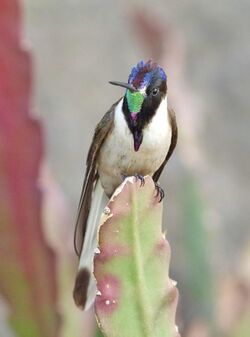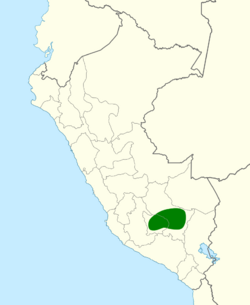Biology:Bearded mountaineer
| Bearded mountaineer | |
|---|---|

| |
| A bearded mountaineer in Ollantaytambo, Peru on December 5, 2015. | |
| Scientific classification | |
| Domain: | Eukaryota |
| Kingdom: | Animalia |
| Phylum: | Chordata |
| Class: | Aves |
| Clade: | Strisores |
| Order: | Apodiformes |
| Family: | Trochilidae |
| Tribe: | Lesbiini |
| Genus: | Oreonympha Gould, 1869 |
| Species: | O. nobilis
|
| Binomial name | |
| Oreonympha nobilis Gould, 1869
| |

| |
The bearded mountaineer or eastern mountaineer (Oreonympha nobilis) is a species of hummingbird in the "coquettes", tribe Lesbiini of subfamily Lesbiinae. It is endemic to Peru.[4][5]
Taxonomy and systematics
The ornithologist John Gould described the species in 1869, from a specimen collected by Henry Whitely at Tinta District, and placed it in its own genus Oreonympha. He recognised a kinship with Oxypogon and Ramphomicron.[6] A study of mitochondrial DNA of hummingbirds shows it to be most closely related to the bearded helmetcrests (Oxypogon sp.) and the rufous-capped thornbill (Chalcostigma ruficeps). The other member of the genus Chalcostigma lay outside the group, suggesting the genus might need revising in the future.[7] In addition, the South American Classification Committee (SACC) of the American Ornithological Society is considering a proposal to merge both Oreonympha and Chalcostigma into Oxypogon.[8]
The SACC, the International Ornithological Committee (IOC), and the Clements taxonomy recognize two subspecies, the nominate O. n. nobilis and O. n. albolimbata.[9][4][10] However, BirdLife International's Handbook of the Birds of the World (HBW) treats these taxa as separate species, the eastern and western mountaineers respectively.[5]
Description
The bearded mountaineer is 14 to 16.5 cm (5.5 to 6.5 in) long including the approximately 2.3 cm (0.91 in) long bill. It weighs about 7 to 9 g (0.25 to 0.32 oz). Adult males of the nominate subspecies have a deep purplish blue forecrown and crown with a narrow black stripe in the middle. The face is bronzy black with a narrow white band at the back. Its gorget is long and narrow, emerald green under the chin and the rest purplish with a bluish tip. The nape, back, and rump are bronzy to bronzy brown. The tail is long and deeply forked; the feathers are bronzy with increasing amounts of white from the innermost to outermost. The center of the breast is white, the sides of the breast and flanks brownish, and the undertail coverts are bronzy brown. The adult female is similar to the male but duller overall and dingier underneath. Its gorget is smaller and mostly white and the tail less deeply forked. Both sexes have black bills and legs. Juveniles are duller than the adults, with a scaly green crown, a dull brown throat, and a yellow mandible.[11]
Males of subspecies O. n. albolimbata has white bands on either side of the crown and its tail is much more coppery. The female has white extending from the same white bands of the crown through the lores to the gorget.[11]
Distribution and habitat
The "eastern" nominate subspecies of bearded mountaineer is found in the departments of Apurímac and Cuzco of south-central Peru, in the drainages of the Urubamba and upper Apurímac rivers. The "western" subspecies O. n. albolimbata is found in Peru's departments of Huancavelica, Ayacucho, and Apurímac, in the drainages of the Mantaro, Pampas, and Chalhuanca rivers.[11]
The species inhabits dry Andean valleys characterized by rocky and scrubby hillsides and open woodland. It occurs in a variety of native plant communities but also is regularly found in tree tobacco (Nicotiana) and Eucalyptus even along roads and in towns. In elevation it ranges from 2,500 to 3,900 m (8,200 to 12,800 ft).[11]
Behavior
Movement
The bearded mountaineer is resident throughout it range.[11]
Feeding
The bearded mountaineer feeds on nectar, primarily that of Agave, cacti, Nicotiana, and Eucalyptus. It feeds both by hovering with an almost vertical stance and tail flicking, but also clings to flowers with open wings. It also eats small arthropods. It is submissive to most other hummingbirds.[11]
Breeding
The bearded mountaineer's breeding phenology has not been documented, though an early author suggest that it might breed in caves above rivers.[11][12]
Vocalization
The bearded mountaineer's vocalizations include "a descending, squeaky series followed by a rich chatter: swee swee chew-chew-chew [and] also a dry dzzrt."[11]
Status
The IUCN uses HBW taxonomy and so treats the subspecies separately as species. Both are assessed as being of Least Concern. Both have restricted ranges; their population numbers are unknown but believed to be stable.[1][2] The species as a whole is described as uncommon to locally common. Human plantings of Eucalyptus and tree tobacco may be beneficial if native vegetation is lost.[11]
References
- ↑ 1.0 1.1 BirdLife International (2016). "Western Mountaineer Oreonympha albolimbata". IUCN Red List of Threatened Species 2016: e.T22727923A94965841. doi:10.2305/IUCN.UK.2016-3.RLTS.T22727923A94965841.en. https://www.iucnredlist.org/species/22727923/94965841. Retrieved 26 February 2022.
- ↑ 2.0 2.1 BirdLife International (2016). "Eastern Mountaineer Oreonympha nobilis". IUCN Red List of Threatened Species 2016: e.T22727930A94966031. doi:10.2305/IUCN.UK.2016-3.RLTS.T22727930A94966031.en. https://www.iucnredlist.org/species/22727930/94966031. Retrieved 26 February 2022.
- ↑ "Appendices | CITES". https://cites.org/eng/app/appendices.php.
- ↑ 4.0 4.1 "Hummingbirds". January 2022. https://www.worldbirdnames.org/new/bow/hummingbirds/.
- ↑ 5.0 5.1 HBW and BirdLife International (2020) Handbook of the Birds of the World and BirdLife International digital checklist of the birds of the world Version 5. Available at: http://datazone.birdlife.org/userfiles/file/Species/Taxonomy/HBW-BirdLife_Checklist_v5_Dec20.zip [.xls zipped 1 MB] retrieved 27 May 2021
- ↑ Gould, John (1869). "Description of a new genus and species of the family Trochilidae". Journal of Zoology 37: 295–96. doi:10.1111/j.1469-7998.1869.tb07330.x. https://books.google.com/books?id=BvIKAAAAIAAJ&q=Oreonympha+nobilis&pg=PA295.
- ↑ McGuire, Jimmy A.; Witt Christopher C.; Remsen, J. V. Jr; Dudley R.; Altshuler, Douglas L. (2008). "A higher-level taxonomy for hummingbird". Journal of Ornithology 150: 155–65. doi:10.1007/s10336-008-0330-x. http://www.msb.unm.edu/birds/publications/McGuire_etal_2008_J.Ornithol._Trochilid_Taxonomy.pdf.
- ↑ Stiles, Gary; Remsen, J.V. Jr. (November 2021). "Revise generic limits in the Lesbiini: A. Expand Oxypogon to include Oreonympha and Chalcostigma, and B. Modify linear sequence". South American Classification Committee of AOS. https://www.museum.lsu.edu/~Remsen/SACCprop930.htm.
- ↑ Remsen, J. V., Jr., J. I. Areta, E. Bonaccorso, S. Claramunt, A. Jaramillo, D. F. Lane, J. F. Pacheco, M. B. Robbins, F. G. Stiles, and K. J. Zimmer. Version 31 January 2022. A classification of the bird species of South America. American Ornithological Society. https://www.museum.lsu.edu/~Remsen/SACCBaseline.htm retrieved February 1, 2022
- ↑ Clements, J. F., T. S. Schulenberg, M. J. Iliff, S. M. Billerman, T. A. Fredericks, J. A. Gerbracht, D. Lepage, B. L. Sullivan, and C. L. Wood. 2021. The eBird/Clements checklist of Birds of the World: v2021. Downloaded from https://www.birds.cornell.edu/clementschecklist/download/ Retrieved August 25, 2021
- ↑ 11.0 11.1 11.2 11.3 11.4 11.5 11.6 11.7 11.8 Drucker, J. and C. W. Sedgwick (2020). Bearded Mountaineer (Oreonympha nobilis), version 1.0. In Birds of the World (T. S. Schulenberg, Editor). Cornell Lab of Ornithology, Ithaca, NY, USA. https://doi.org/10.2173/bow.beamou1.01 retrieved February 26, 2022
- ↑ Morrison, A. (1939). "The birds of the department of Huancavelica, Peru". Ibis 14 (3): 453–486.
Further reading
- Schulenberg, Thomas S. (2007). Birds of Peru. Princeton, NJ: Princeton University Press. pp. 242–43. ISBN 978-0-691-13023-1. https://books.google.com/books?id=yFuWUc7l0uQC&q=Bearded+Mountaineer&pg=PA242. Retrieved 11 June 2011.
Wikidata ☰ Q286615 entry
 |


